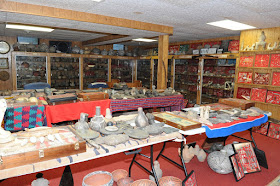 |
| Image Credit : FBI |
Since that time, the Bureau’s Art Crime division has been tasked with identifying just who are the rightful owners of more than 7,000 objects from around the globe that were found in the now-deceased collector's main residence. The objects once filled the house where Miller resided with his wife, his basement, a second, unoccupied residence on the property; and several outbuildings, accessible via a tunnel which connected the house to the adjoining buildings.
Prior to the Federal seizure Miller had made no secret that he was an avid collector, even going so far as to have area schoolchildren over for tours of his amateur museum. Much of his collection was displayed inside carefully labeled glass showcases or spread out on folding tables. An individual well-known in his community, Miller was also profiled in local papers who wrote articles about his artifacts, about his service during World War II and about his connection to the Manhattan Project where he helped build the world's first atomic bomb.
Cooperating throughout the investigation, Miller voluntarily waived his title to all of the seized objects prior to his death at 91 in 2015. As part of that cooperation, he relinquished the artefacts that he had acquired in violation of state and federal law and international treaties.
Some of the anthropological and archaeological Miller collected over his lifetime included:
Native American arrowheads, points and projectiles from throughout the western United States
fossils
40 pre-Columbian artifacts
hundreds of terracotta vases
two fossilized eggs
an Egyptian sarcophagus
500 sets of human remains looted largely from Native American burial grounds
a life-size Chinese terracotta figurine
an Italian mosaic
a South American dugout canoe
a bear skin rug
carved boomerangs
coins
an 1873 Winchester carbine purportedly fired by a Lakota Indian at the Battle of Little Big Horn;
a Tibetan bell
jade, purportedly form the Ming Dynasty
bullet casings detected by a metal detector at Civil War battlefields
axes;
a chunk of concrete that Miller purportedly claimed was from the bunker in which Adolf Hitler committed suicide.
The task of returning the forfeited objects to their rightful owners is not an easy one. Nor is it easy to determine which artefacts crossed the line from legal to illegal or were the result of outright looting. Additionally no single art historian or archaeologist can singularly provide the US government authorities with sufficient expertise about the origins of every object that Miller had in his possession as the collection itself was extremely varied.
 |
| Image Credit: FBI |
 |
| Screen Capture: FBI digital archive, Via FBI. |
 |
| Image Credit: FBI |

No comments:
Post a Comment